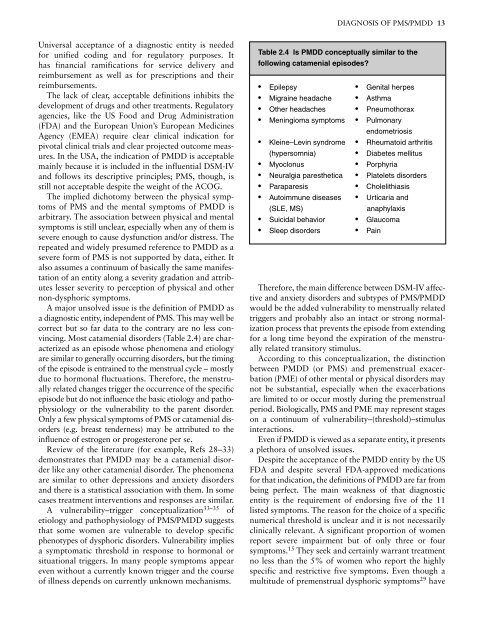Premenstrual Syndromes : PMS and PMDD - Rutuja :: The site ...
Premenstrual Syndromes : PMS and PMDD - Rutuja :: The site ...
Premenstrual Syndromes : PMS and PMDD - Rutuja :: The site ...
Create successful ePaper yourself
Turn your PDF publications into a flip-book with our unique Google optimized e-Paper software.
Universal acceptance of a diagnostic entity is needed<br />
for unified coding <strong>and</strong> for regulatory purposes. It<br />
has financial ramifications for service delivery <strong>and</strong><br />
reimbursement as well as for prescriptions <strong>and</strong> their<br />
reimbursements.<br />
<strong>The</strong> lack of clear, acceptable definitions inhibits the<br />
development of drugs <strong>and</strong> other treatments. Regulatory<br />
agencies, like the US Food <strong>and</strong> Drug Administration<br />
(FDA) <strong>and</strong> the European Union’s European Medicines<br />
Agency (EMEA) require clear clinical indication for<br />
pivotal clinical trials <strong>and</strong> clear projected outcome measures.<br />
In the USA, the indication of <strong>PMDD</strong> is acceptable<br />
mainly because it is included in the influential DSM-IV<br />
<strong>and</strong> follows its descriptive principles; <strong>PMS</strong>, though, is<br />
still not acceptable despite the weight of the ACOG.<br />
<strong>The</strong> implied dichotomy between the physical symptoms<br />
of <strong>PMS</strong> <strong>and</strong> the mental symptoms of <strong>PMDD</strong> is<br />
arbitrary. <strong>The</strong> association between physical <strong>and</strong> mental<br />
symptoms is still unclear, especially when any of them is<br />
severe enough to cause dysfunction <strong>and</strong>/or distress. <strong>The</strong><br />
repeated <strong>and</strong> widely presumed reference to <strong>PMDD</strong> as a<br />
severe form of <strong>PMS</strong> is not supported by data, either. It<br />
also assumes a continuum of basically the same manifestation<br />
of an entity along a severity gradation <strong>and</strong> attributes<br />
lesser severity to perception of physical <strong>and</strong> other<br />
non-dysphoric symptoms.<br />
A major unsolved issue is the definition of <strong>PMDD</strong> as<br />
a diagnostic entity, independent of <strong>PMS</strong>. This may well be<br />
correct but so far data to the contrary are no less convincing.<br />
Most catamenial disorders (Table 2.4) are characterized<br />
as an episode whose phenomena <strong>and</strong> etiology<br />
are similar to generally occurring disorders, but the timing<br />
of the episode is entrained to the menstrual cycle – mostly<br />
due to hormonal fluctuations. <strong>The</strong>refore, the menstrually<br />
related changes trigger the occurrence of the specific<br />
episode but do not influence the basic etiology <strong>and</strong> pathophysiology<br />
or the vulnerability to the parent disorder.<br />
Only a few physical symptoms of <strong>PMS</strong> or catamenial disorders<br />
(e.g. breast tenderness) may be attributed to the<br />
influence of estrogen or progesterone per se.<br />
Review of the literature (for example, Refs 28–33)<br />
demonstrates that <strong>PMDD</strong> may be a catamenial disorder<br />
like any other catamenial disorder. <strong>The</strong> phenomena<br />
are similar to other depressions <strong>and</strong> anxiety disorders<br />
<strong>and</strong> there is a statistical association with them. In some<br />
cases treatment interventions <strong>and</strong> responses are similar.<br />
A vulnerability–trigger conceptualization 33–35 of<br />
etiology <strong>and</strong> pathophysiology of <strong>PMS</strong>/<strong>PMDD</strong> suggests<br />
that some women are vulnerable to develop specific<br />
phenotypes of dysphoric disorders. Vulnerability implies<br />
a symptomatic threshold in response to hormonal or<br />
situational triggers. In many people symptoms appear<br />
even without a currently known trigger <strong>and</strong> the course<br />
of illness depends on currently unknown mechanisms.<br />
DIAGNOSIS OF <strong>PMS</strong>/<strong>PMDD</strong> 13<br />
Table 2.4 Is <strong>PMDD</strong> conceptually similar to the<br />
following catamenial episodes?<br />
● Epilepsy ● Genital herpes<br />
● Migraine headache ● Asthma<br />
● Other headaches ● Pneumothorax<br />
● Meningioma symptoms ● Pulmonary<br />
endometriosis<br />
● Kleine–Levin syndrome ● Rheumatoid arthritis<br />
(hypersomnia) ● Diabetes mellitus<br />
● Myoclonus ● Porphyria<br />
● Neuralgia paresthetica ● Platelets disorders<br />
● Paraparesis ● Cholelithiasis<br />
● Autoimmune diseases ● Urticaria <strong>and</strong><br />
(SLE, MS) anaphylaxis<br />
● Suicidal behavior ● Glaucoma<br />
● Sleep disorders ● Pain<br />
<strong>The</strong>refore, the main difference between DSM-IV affective<br />
<strong>and</strong> anxiety disorders <strong>and</strong> subtypes of <strong>PMS</strong>/<strong>PMDD</strong><br />
would be the added vulnerability to menstrually related<br />
triggers <strong>and</strong> probably also an intact or strong normalization<br />
process that prevents the episode from extending<br />
for a long time beyond the expiration of the menstrually<br />
related transitory stimulus.<br />
According to this conceptualization, the distinction<br />
between <strong>PMDD</strong> (or <strong>PMS</strong>) <strong>and</strong> premenstrual exacerbation<br />
(PME) of other mental or physical disorders may<br />
not be substantial, especially when the exacerbations<br />
are limited to or occur mostly during the premenstrual<br />
period. Biologically, <strong>PMS</strong> <strong>and</strong> PME may represent stages<br />
on a continuum of vulnerability–(threshold)–stimulus<br />
interactions.<br />
Even if <strong>PMDD</strong> is viewed as a separate entity, it presents<br />
a plethora of unsolved issues.<br />
Despite the acceptance of the <strong>PMDD</strong> entity by the US<br />
FDA <strong>and</strong> despite several FDA-approved medications<br />
for that indication, the definitions of <strong>PMDD</strong> are far from<br />
being perfect. <strong>The</strong> main weakness of that diagnostic<br />
entity is the requirement of endorsing five of the 11<br />
listed symptoms. <strong>The</strong> reason for the choice of a specific<br />
numerical threshold is unclear <strong>and</strong> it is not necessarily<br />
clinically relevant. A significant proportion of women<br />
report severe impairment but of only three or four<br />
symptoms. 15 <strong>The</strong>y seek <strong>and</strong> certainly warrant treatment<br />
no less than the 5% of women who report the highly<br />
specific <strong>and</strong> restrictive five symptoms. Even though a<br />
multitude of premenstrual dysphoric symptoms 29 have


